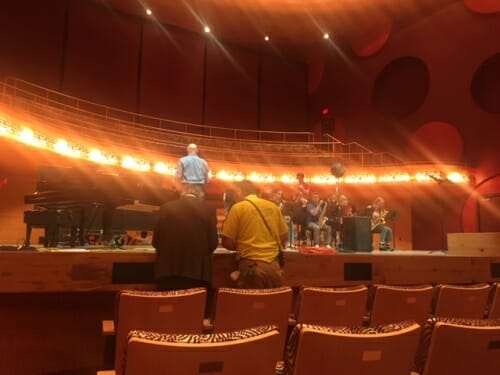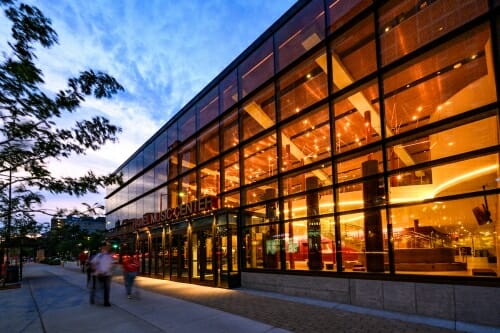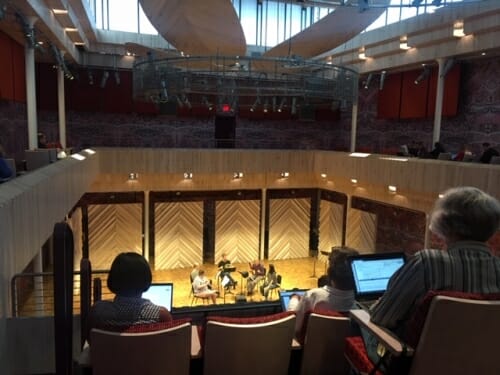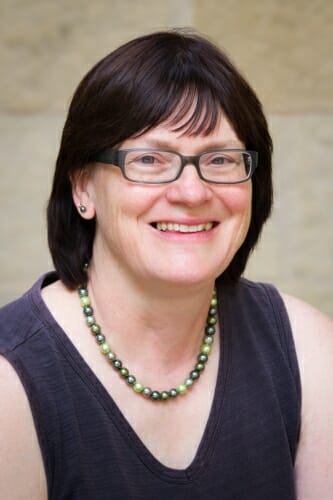Stay tuned: Hamel Music Center gets ready for opening
It would normally be impolite to bring a book to a musical performance. Bad manners to cross-stitch. Check your email on a laptop? Certainly not.
But this wasn’t just any performance.
It was a two-day tune-up Sept. 19 and 20 of the new Hamel Music Center, located at the corner of University Avenue and Lake Street. An audience of volunteers witnessed the process as acoustician Richard Talaske led the tuning and sound engineers manipulated motorized curtains, banners and other surroundings. They focused the first day on the 660-seat Mead Witter Foundation Concert Hall and the second on the 300-seat Collins Recital Hall.
“We’d really like to know how you feel on stage,” Talaske said to a group of performers. “How easy is it to hear one another within the ensemble? Does the timbre of your instrument sound like you think it should sound?”
An ensemble performs while professional acousticians perform the final tuning at the Hamel Music Center. Sound engineers manipulated motorized curtains, banners and other surroundings to ensure a clean, crisp soundscape. UW–Madison video by Nate Moll
Talaske wants to get the sound just right for the audience and for the musicians. He moved throughout the performance space to hear from different seats.
The Pro Arte Quartet briefly became a quintet as Talaske took a seat on the stage. And then he was off and running.
“Do you mind playing that piece again? I’d like to listen upstairs.”

“We’d really like to know how you feel onstage,” Talaske said to a group of performers. “How easy is it to hear one another within the ensemble? Does the timbre of your instrument sound like you think it should sound?” Photo: Käri Knutson
He also relied on the ears of others.
“How does that sound?” Talaske asked the audience after a faculty ensemble played.
The reviews were shouted in response.
“Love it!”
“It’s got great clarity.”
“It’d be interesting to hear some of the faster and louder parts with this setting.”
The subtle changes in sound may not be obvious to everyone in the audience but can be crucial for musicians, said Susan C. Cook, director of the Mead Witter School of Music.
“You don’t know what you’re doing if you can’t hear yourself,” Cook explained.
She likens it to being numbed at the dentist: You know you’re talking but can’t really control what you sound like.
“These halls let you know,” Cook said.
The performers will get to know the space better over time, making their own adjustments on what they hear.
“They’re going to learn the hall like they learn an instrument,” Cook said.
It’s quite a step up from the School of Music’s current performance venues, Morphy Hall and Mills Hall in the Mosse Humanities Building. Members of the Monona Brass saw the Hamel Music Center’s progress, but the tune-up was their first opportunity to hear it.
“This is so much warmer and inviting,” said Nick Hill, a sophomore majoring in trumpet performance. “Mills has the ambience of an operation theater. It’s just really harsh.”
The rest of the group harmoniously agreed.
“It sounds like a bathtub,” said Declan Mulkerin, a junior majoring in horn performance.
“It was definitely time for an upgrade,” said Kaitlyn Rian, a sophomore majoring in music education.
Sam Weber, a senior majoring in euphonium performance, grew up in Sun Prairie. He would come to Madison for Badger games as a kid and long remembers seeing a sign: “New music school coming soon.”
“Just walking in, I looked at it and I was like, ‘I love it.’ And then I heard it. I loved it more,” Weber said.
It’s not just what they heard, it’s what they didn’t hear. Consider this already oft-told story.
It happened during a concerto competition at Mills Hall last year. The piece started out boldly, gradually becoming solemn toward the end, intending to create a moment of reflection.
Then the sound of the jazz band came marching in from the rehearsal space next door.
That wasn’t the only kind of unwelcome accompaniment.

The Hamel Music Center, pictured at dusk on Sept. 18, is located at the corner of University Avenue and Lake Street. Photo: Bryce Richter
“The main problem with Morphy, besides being way too cold or way too hot, there was always this horrible rattling sound,” Mulkerin said. “No silence was ever a true silence.”
“Today they asked everyone to be quiet and it was pure silence. I don’t think I’ve ever heard that in the Humanities Building once,” said Jordan DeWester, a junior majoring in tuba performance.
Silence is achievable in the new building, thanks to an acoustic joint (a two-inch gap) that isolates each music hall from vibrations conducted by the building’s hard surfaces. Plumbing and other mechanical systems are routed through corridors and back-of-house spaces to keep any noise or vibration from transferring to the structures surrounding the performance halls and rehearsal hall. Pipes are wrapped with additional insulation to absorb sound.
That kind of engineering is a welcome accompaniment.
“It completely changed how we projected and how we listened to each other,” Mulkiren said.
“At first when we started playing, I had a sense my sound was getting lost in the space,” Hill said. “Then when they increased the resonance back to us, it felt much more like we were filling up the hall.”
“I think it’s easier for us to be musical,” Rian said. “I felt like I could do a lot more with the dynamics in the space because I could really hear them.”
Beyond the sound, the students appreciate having a space specifically for performing.
“When musicians are excited about playing in a space, it translates to the performance,” DeWester said. “Our level of focus and just general musicianship stepped up because we knew this was a big deal and something we really care about.”

The Pro Arte Quartet briefly became a quintet as Talaske took a seat on the stage. And then he was off and running. “Do you mind playing that piece again? I’d like to listen upstairs.” Photo: Käri Knutson
That’s music to the ears of Cook, who was brought to tears in the best possible way after hearing the first musicians take the stage.
The center formally opens with a weekend celebration Oct. 25–27. Events include a ribbon cutting, welcoming remarks from Chancellor Rebecca Blank, open house receptions, and three days of performances showcasing the Mead Witter School of Music’s undergraduate and graduate students, current and retired faculty, and alumni. As a gift to the community, admission to the opening weekend’s public concerts will free but tickets will be required.
While there are many impressive features to the new building — a copper chandelier, grand staircase, storage galore — that Cook enjoys showing off, one of her favorites is pretty simple. A window faces west, looking out at the hustle and bustle of University Avenue and the neighboring Chazen Museum of Art. It’s nothing fancy. But it’s symbolic.
“If we can look out, they can look in,” Cook said. “We are now interwoven with the university.”




